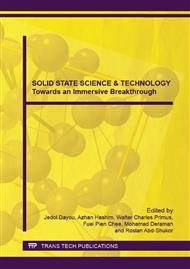[1]
P.A. Ita, Filler Requirements In the Tire Industry: Carbon Black & Precipitated Silica. 2005. Tire Technology Expo & Conference 2005, Koln Messe, Cologne, Germany.
Google Scholar
[2]
John Dinkel. 1995. Where the Silica Meets the Road, information on http: /discovermagazine. com/1995/apr/wherethesilicame497.
Google Scholar
[3]
M. J. Wang, Billerica, Effect of Filler-Elastomer Interaction on Tire Tread Performance Part II. Raw Materials and Applications. KGK January/February 2008, 33-42.
Google Scholar
[4]
Chanvoot Koolhiran, James L. White. Comparison of Intermeshing Rotor and Traditional Rotors of Internal Mixers in Dispersing Silica and Other Fillers. Journal of Applied Polymer Science, Vol. 78 (2000) 1551–1554.
DOI: 10.1002/1097-4628(20001121)78:8<1551::aid-app120>3.0.co;2-#
Google Scholar
[5]
F. Cataldo. Preparation of Silica-Based Rubber Compounds without the Use of a Silane Coupling Agent through the Use of Epoxidized Natural Rubber, Macromolecular Materials and Engineering, 287 (2002) 348-352.
DOI: 10.1002/1439-2054(20020501)287:5<348::aid-mame348>3.0.co;2-1
Google Scholar
[6]
K.M. George, J.K. Varkey, B. George, S. Joseph, K.T. Thomas, and N.M. Mathew, Physical and Dynamic Mechanical Properties of Silica Filled Nitrile Rubber Modified with Epoxidized Natural Rubber, Elastomere und Kunststoffe, KGK Oktober 2006, 544-549.
DOI: 10.1002/app.10658
Google Scholar
[7]
Naohiko Kikuchi, Kazuo Hochi, Takuya Horuguchi. Eco Tire. U.S. Patent No. 7275572 (2007).
Google Scholar
[8]
Your Question Answered, Rubber Developments, Vol. 42, No. 2 (1989) 46-47.
Google Scholar
[9]
I.R. Gelling, Epoxidised Natural Rubber, Journal of Natural Rubber Research, Vol. 6 No. 3 (1991) 184-205.
Google Scholar
[10]
K. T. Thomas, Molecular Breakdown of Different Forms of Natural Rubber and Its Influence on Properties of Their Mixes and Vulcanizates, Thesis, Cochin University of Science and Technology, (1997).
Google Scholar
[11]
R. N. Datta, N. M. Huntink, S. Datta, A. G. Talma, Rubber Vulcanizates Degradation and Stabilization, Rubber Chemistry and Technology, Vol. 80 (2007) 436-480.
DOI: 10.5254/1.3548174
Google Scholar
[12]
Byron H. To, Frederick Ignatz-Hoover and Gilbert Anthoine, Better Thermal and Thermal Oxidative Aging Resistance, Rubber & Plastics News, October 16, (2006) 1-7.
Google Scholar
[13]
Martin P. Cohen, Richard M. D'Sidocky, Rubber Chemicals, Encyclopedia of Polymer Science and Technology, John Wiley & Sons (2004) 557-612.
Google Scholar
[14]
Z. H. Li, J. Zhang, S. J. Chen, Effects of Carbon Blacks with Various Structures on Vulcanization and Reinforcement of Filled Ethylene-Propylene-Diene Rubber, eXPRESS Polymer Letters Vol. 2, No. 10 (2008) 695–704.
DOI: 10.3144/expresspolymlett.2008.83
Google Scholar
[15]
L. Gonza´lez,A. Rodrı´guez, J.L. Valentı´n, A. Marcos-Ferna´ndez, P. Posadas, Conventional and Efficient Crosslinking of Natural Rubber, Effect of Heterogeneities on the Physical Properties, Elastomere und Kunststoffe, KGK December (2005).
Google Scholar
[16]
Sadhan K. De, Jim R. White, Rubber Technologist's Handbook, Vol. 1, (2001) 184-185.
Google Scholar
[17]
Ruldoph D. Deanin, Polymer Structure, Properties and Applications, Cahners Books (1972) 423-425.
Google Scholar
[18]
Brendan Rodgers and Walter Waddell, The Science of Rubber Compounding, The Science and Technology of Rubber, Elsevier Academic Press (2005) 401-454.
DOI: 10.1016/b978-012464786-2/50012-2
Google Scholar


